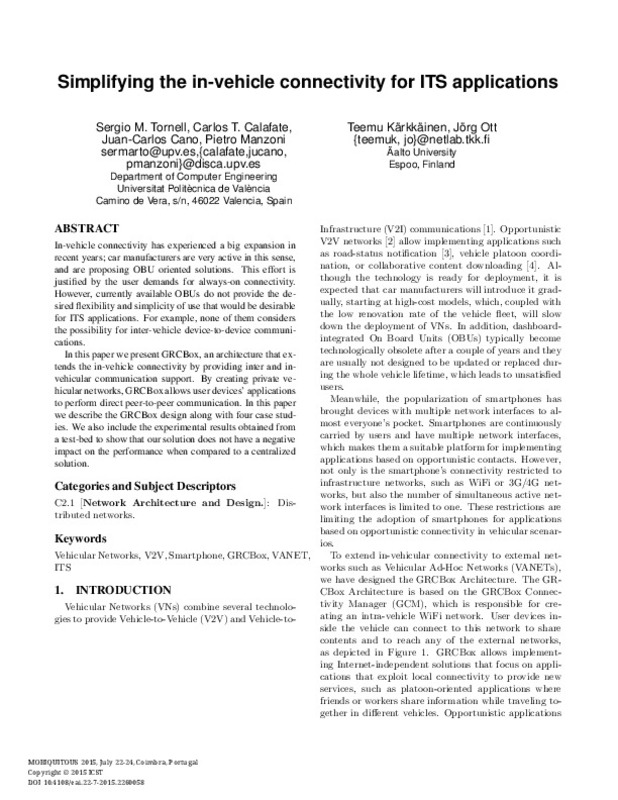Tornell, SM.; Tavares De Araujo Cesariny Calafate, CM.; Cano Escribá, JC.; Manzoni, P.; Kärkkäinen, T.; Ott, J. (2015). Simplifying the in-vehicle connectivity for ITS applications. EAI Endorsed Transactions on Energy Web. 2(7):1-10. https://doi.org/10.4108/eai.22-7-2015.2260058
Por favor, use este identificador para citar o enlazar este ítem: http://hdl.handle.net/10251/64931
|
Título:
|
Simplifying the in-vehicle connectivity for ITS applications
|
|
Autor:
|
Tornell, Sergio M.

 Tavares de Araujo Cesariny Calafate, Carlos Miguel
Tavares de Araujo Cesariny Calafate, Carlos Miguel

 Cano Escribá, Juan Carlos
Cano Escribá, Juan Carlos

 Manzoni, Pietro
Kärkkäinen, Teemu
Ott, Jörg
Manzoni, Pietro
Kärkkäinen, Teemu
Ott, Jörg
|
|
Entidad UPV:
|
Universitat Politècnica de València. Departamento de Informática de Sistemas y Computadores - Departament d'Informàtica de Sistemes i Computadors
|
|
Fecha difusión:
|
|
|
Resumen:
|
[EN] In-vehicle connectivity has experienced a big expansion in recent years; car manufacturers are very active in this sense, and are proposing OBU oriented solutions. This effort is justified by the user demands for ...[+]
[EN] In-vehicle connectivity has experienced a big expansion in recent years; car manufacturers are very active in this sense, and are proposing OBU oriented solutions. This effort is justified by the user demands for always-on connectivity. However, currently available OBUs do not provide the desired
flexibility and simplicity of use that would be desirable for ITS applications. For example, none of them considers the possibility for inter-vehicle device-to-device communications. In this paper we present GRCBox, an architecture that extends the in-vehicle connectivity by providing inter and invehicular
communication support. By creating private vehicular networks, GRCBox allows user devices’ applications to perform direct peer-to-peer communication. In this paper we describe the GRCBox design along with four case studies. We also include the experimental results obtained from
a test-bed to show that our solution does not have a negative impact on the performance when compared to a centralized solution.
[-]
|
|
Palabras clave:
|
Vehicular networks
,
V2V
,
Smartphone
,
GRCBox
,
VANET
,
ITS
|
|
Derechos de uso:
|
Reconocimiento (by)
|
|
Fuente:
|
EAI Endorsed Transactions on Energy Web. (issn:
2032-944X
)
|
|
DOI:
|
10.4108/eai.22-7-2015.2260058
|
|
Editorial:
|
Institute for Computer Sciences, Social Informatics and Telecommunications Engineering (ICST)
|
|
Versión del editor:
|
http://dx.doi.org/10.4108/eai.22-7-2015.2260058
|
|
Código del Proyecto:
|
info:eu-repo/grantAgreement/MINECO//TEC2014-52690-R/ES/INTEGRACION DEL SMARTPHONE Y EL VEHICULO PARA CONECTAR CONDUCTORES, SENSORES Y ENTORNO A TRAVES DE UNA ARQUITECTURA DE SERVICIOS FUNCIONALES/
info:eu-repo/grantAgreement/MINECO//BES-2012-052673/ES/BES-2012-052673/
info:eu-repo/grantAgreement/MINECO//EEBB-I-14-07890/ES/EEBB-I-14-07890/
|
|
Agradecimientos:
|
This work was partially supported by the Ministerio de Econom´ıa y Competitividad, Programa Estatal de Investigaci´on,
Desarrollo e Innovaci´on Orientada a los Retos de la Sociedad, Proyectos I+D+I 2014, Spain, under Grant ...[+]
This work was partially supported by the Ministerio de Econom´ıa y Competitividad, Programa Estatal de Investigaci´on,
Desarrollo e Innovaci´on Orientada a los Retos de la Sociedad, Proyectos I+D+I 2014, Spain, under Grant TEC2014-52690-R, BES-2012-052673 and EEBB-I-14-07890.
[-]
|
|
Tipo:
|
Artículo
|









